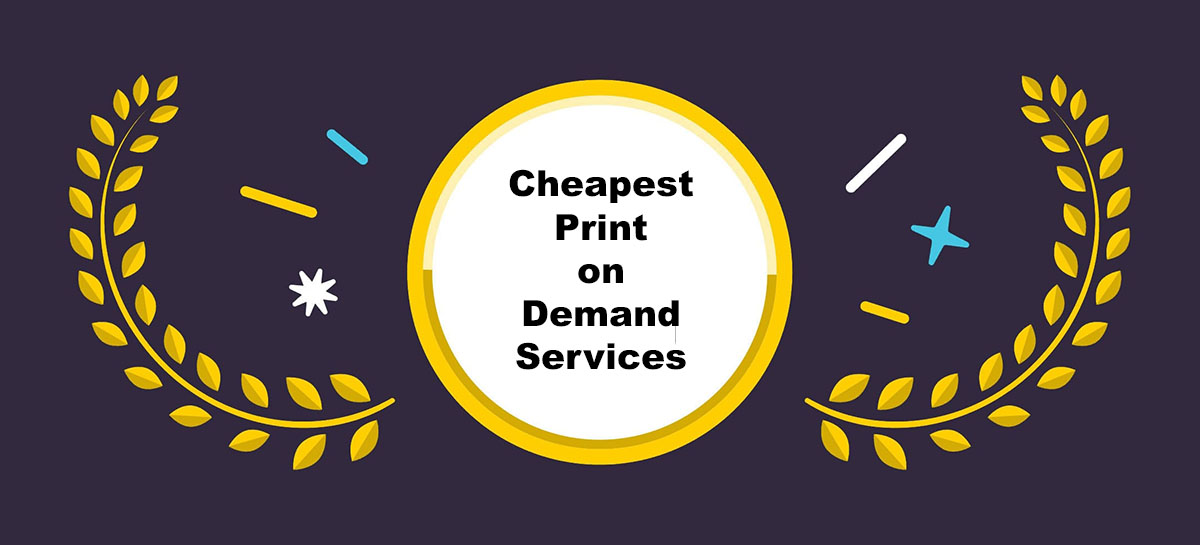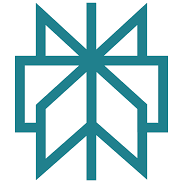Over the years I’ve sold on Shopify, Etsy, and even WooCommerce — using nearly every POD platform available.
Here are the services that actually helped me keep costs down without crushing my profit margins or ruining my brand.
| Platform | T-Shirt Base Price (USD) | Shipping (US) | Fulfilment Speed | Branding Options | Best For | Key Strengths |
|---|---|---|---|---|---|---|
| Printify | From $7.50 | From $4.00 | 2–7 days | Depends on supplier | Low-cost scaling | Cheapest base prices, supplier flexibility |
| Gelato | From $8.95 | $3.00–$5.00 | 1–4 days (global) | Basic | International sellers | Fast global fulfilment |
| Printful | From $12.95 | From $3.99 | 2–5 days | Full branding suite | Premium DTC brands | Quality, branding, integrations |
| Teespring | From $10.22 | Free | 5–10 days | Limited (storefront only) | Creators & influencers | No upfront costs, easy setup |
| Redbubble | From $13.00 | Included | 7–15 days | None | Passive artists | Built-in marketplace traffic |
| Zazzle | Varies | From $3.00 | 3–7 days | Limited | Event & stationery niches | Niche products, marketplace exposure |
| SPOD | From $6.39 | From $3.57 | 48 hours average | Basic branding options | Speed-focused sellers | Fastest shipping, solid quality |
1. Printify – Best Overall for Low Prices
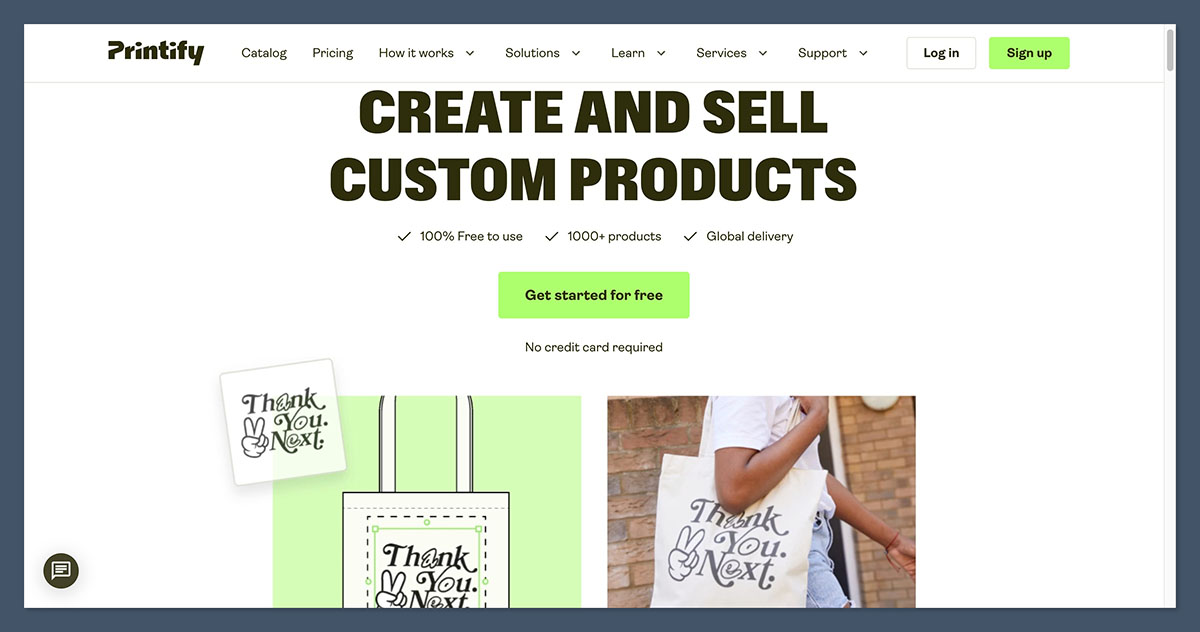
Printify is the cheapest print on demand provider across the board — mostly because of its supplier marketplace model.
Instead of being locked into one manufacturer like you are with Printful, you get access to a wide range of production partners located across the US, UK, Europe, and beyond.
That gives you the power to choose based on what matters to you — whether it’s the lowest price, fastest turnaround, or closest location to your customers.
This flexibility is what makes Printify stand out when you’re focused on keeping costs low. It’s ideal for high-volume sellers who want options — and don’t mind a bit of research up front.
Why I Use Printify:
- T-shirts start at $7.50 (Gildan 5000 from Monster Digital)
- You can compare suppliers by price, location, and customer reviews
- Shipping from the US is usually $4.00 or less, even for tracked delivery
- Access to local fulfilment in the US, Canada, UK, and Australia
- Massive product range — apparel, mugs, posters, phone cases, and more
Once you figure out which suppliers are reliable (and yes, that does mean ordering test samples), you can build a lean, scalable POD setup that keeps costs predictable and profits stable.
Pros:
- Cheapest base prices on most common products
- Easy integration with Shopify, Etsy, and WooCommerce
- The Premium plan ($29/month) gives you 20% off all products
- Suppliers in multiple countries reduce shipping times for international orders
- Transparent supplier ratings and production times
Cons:
- Quality varies between suppliers — testing is essential
- No standard packaging or branding across vendors
- Customer service is decent but not fast during peak seasons
- No direct support for marketplaces like Amazon (you’ll need a workaround)
Best For:
Printify works best for beginners who want to test POD without overpaying and experienced sellers scaling to multiple markets.
If you’re focused on getting the most margin per sale — especially on core items like shirts and mugs — Printify is hands-down the best choice.
Pricing Summary:
| Product | Base Price | Shipping (US) |
|---|---|---|
| Gildan 5000 Tee | $7.50 | $4.00 |
| Ceramic Mug | $4.25 | $5.00 |
| Hoodie | $19.80 | $6.50 |
If you’re using Shopify or Etsy and need to keep COGS (cost of goods sold) tight, this combo of low product cost and competitive shipping is hard to beat.
Also worth noting — the Premium plan easily pays for itself if you’re doing more than 30–40 orders a month.
That 20% discount takes the Gildan tee price down to $6.00, which leaves plenty of room for ads, branding, and profit.
Want to future-proof your margins? Start with Printify and make sure you test 2–3 suppliers per product type before launching ads or scaling your listings.
2. Gelato – Best for International Sellers
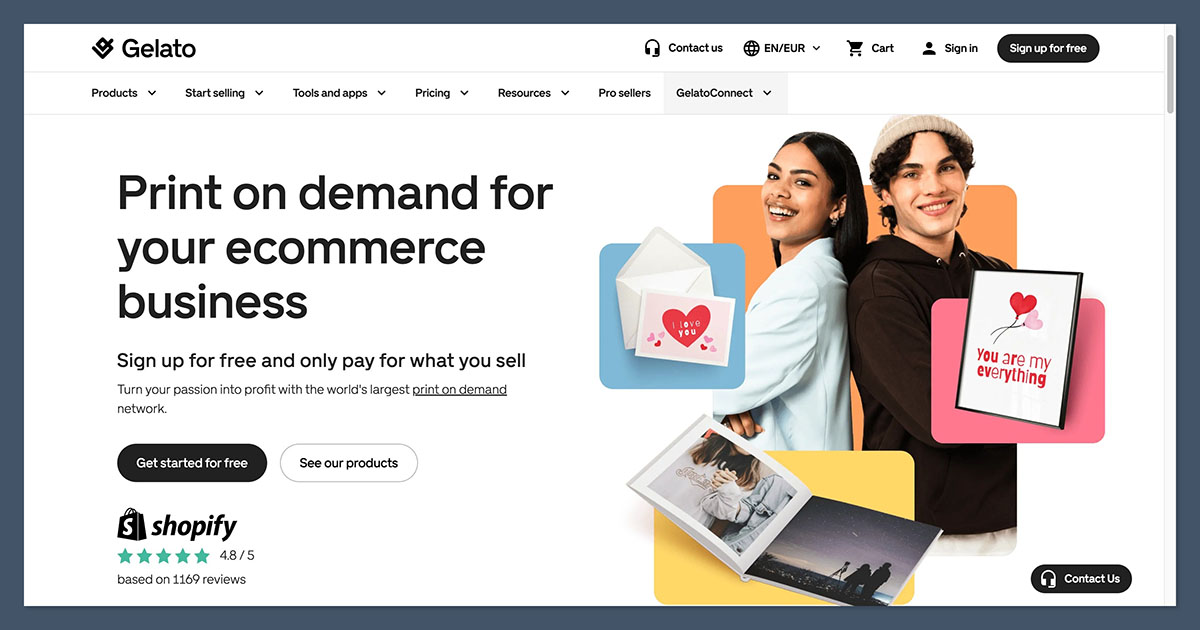
Gelato is a game changer if you sell outside the US.
Their biggest advantage is local production in over 30 countries, which dramatically cuts shipping times, avoids import fees, and makes your store feel faster and more professional to buyers overseas.
Most POD companies focus heavily on the US, but if you’re selling to Europe, Australia, or Canada, those shipping costs add up fast.
What I like most about Gelato is that it’s designed for global scale.
Whether you’re based in the UK, selling to Germany, or launching to Canada, Gelato lets you offer competitive shipping and delivery times that make your brand feel local, no matter where you’re based.
What I Like About Gelato:
- T-shirt base price is around $8.95 (Bella+Canvas 3001)
- Shipping to most of Europe is between $3.00 and $5.00
- Integrates seamlessly with Shopify, Etsy, and WooCommerce
- Most orders are fulfilled and shipped within 72 hours
- Local fulfilment in major markets: Germany, UK, France, Australia, Brazil, and more
One thing that stood out to me was how much better the customer experience is when orders don’t cross borders.
My return rates dropped, delivery complaints went down, and I could advertise 2–5 day shipping in Europe without lying.
Pros:
- Fast global delivery thanks to local fulfilment centres
- Consistent packaging and product quality across locations
- Branded tracking pages and white-label delivery
- Reliable dashboard for tracking, editing, and re-routing orders
- Supports PDF invoices, multiple users, and branded templates for pro sellers
Cons:
- Slightly higher base prices than Printify (especially on apparel)
- The product range isn’t as deep — fewer accessories and niche products
- Some countries still rely on US fulfilment if no local partner is available
- No built-in marketplace, so you’ll need your own storefront
Best For:
Gelato is ideal for brands selling internationally. If you’re based in the UK, Australia, or mainland Europe, or you’re targeting global customers, it’s one of the most efficient POD solutions available.
Pricing Summary:
| Product | Base Price | Shipping (Germany) |
|---|---|---|
| Bella Canvas Tee | $8.95 | $3.50 |
| Poster (A4) | $5.90 | $4.20 |
| Tote Bag | $10.90 | $5.00 |
While it’s not the cheapest platform in terms of unit price, what you save on shipping often offsets the difference.
For example, shipping a shirt from the US to Germany via Printful or Printify can easily cost $9–$12. With Gelato, you’re getting it down to $3–$5, with better delivery speeds.
If you’re aiming for fast delivery and low total cost per order, especially outside the US, Gelato should be at the top of your list.
I’ve used it on multiple international campaigns, and it’s made it much easier to maintain profit margins while delivering a solid customer experience.
3. Printful – Best for Branding and Quality (But Not Cheap)
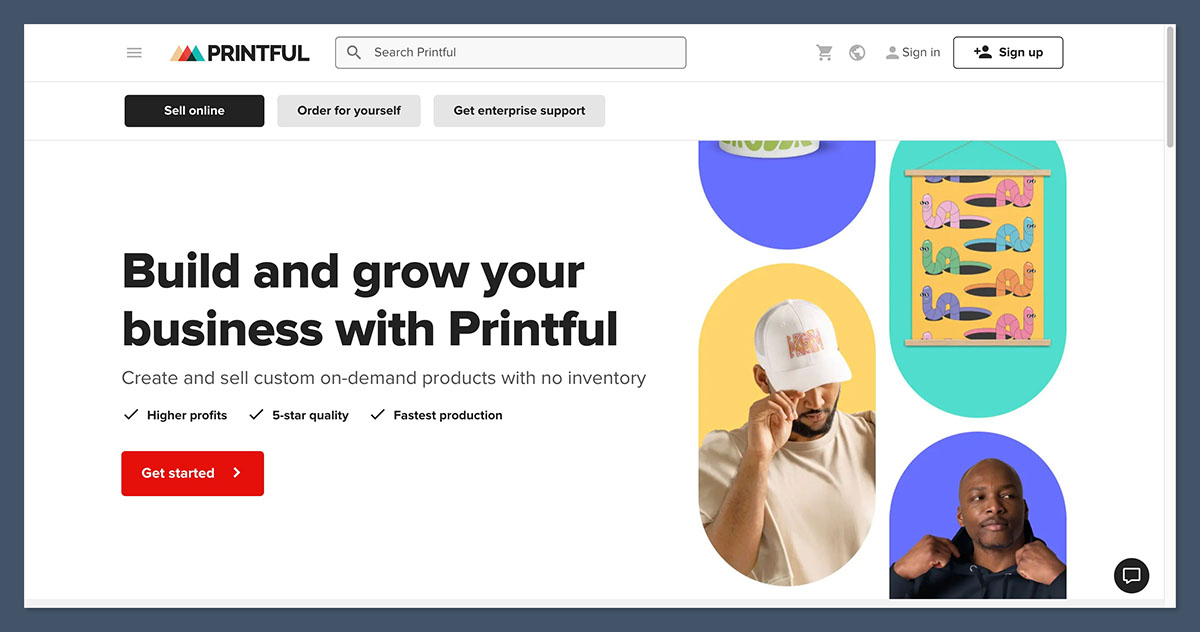
Printful is the gold standard when it comes to quality and branding — but that quality comes at a premium. If you’re trying to run a low-cost, high-margin print on demand store, you’ll quickly notice the higher base prices.
But if you care about how your products feel in-hand, how your packaging reflects your brand, and how many refunds you don’t have to issue — Printful makes a strong case.
For me, Printful has always been the go-to for premium print on demand. Customers don’t complain about quality. They notice the extra touch with the branding. And that builds loyalty over time.
While it’s not built for lean, volume-based stores, Printful is perfect if you’re pricing your products higher and selling on brand value, not just price.
My Experience with Printful:
- T-shirts start at $12.95 (Bella+Canvas 3001)
- Branding add-ons include custom inside neck labels, pack-ins, logo packing slips, and more
- Orders typically ship within 3–5 business days from fulfilment centres in the US, EU, and Mexico
- Product quality is consistent — I’ve had fewer returns using Printful than any other POD platform
It also helps that the design interface and backend dashboard are extremely user-friendly.
Whether you’re syncing with Shopify or Etsy, uploading product mockups, or managing fulfilment rules, Printful’s system is smooth and well-built. The tech side rarely gets in your way.
Pros:
- Consistently high product quality across all categories
- Fully branded packaging options available (great for DTC brands)
- Clean and responsive integrations with Shopify, Etsy, and others
- Strong European fulfilment (Spain, Latvia) plus Mexico and US coverage
- Reliable customer service and support team
Cons:
- Higher base prices mean lower margins if you’re not charging premium prices
- Branding features (like inside labels) cost extra and add up fast
- No choice of supplier per product — you’re locked into Printful’s fulfilment only
- Shipping can still be expensive for international orders unless you’re fulfilling locally
Best For:
Printful is best suited to brands that prioritise quality and customer experience.
If you’re running a premium Shopify store, have an audience that expects polish, or want to position your brand as more than just another merch line, this is the platform to use.
It’s especially good for DTC (direct-to-consumer) brands where branding is a critical part of the buying experience.
Printful is also the most reliable platform I’ve used when sending products as gifts, event swag, or influencer campaigns — the kind of orders where you don’t want a surprise quality issue.
Pricing Summary:
| Product | Base Price | Shipping (US) |
|---|---|---|
| Bella Canvas 3001 | $12.95 | $3.99 |
| Hoodie (Unisex) | $25.95 | $6.50 |
| Mug | $7.95 | $5.00 |
So yes, the prices are higher — but what you get is better packaging, branded presentation, and repeat customers who know what to expect.
If your goal is to build a brand with staying power (not just flip designs), then Printful’s pricing makes sense.
You’re investing in fewer customer complaints, fewer chargebacks, and better product reviews — which ultimately adds more long-term value than shaving off a dollar or two on the front end.
4. Teespring / Spring – Best for Creators with No Budget
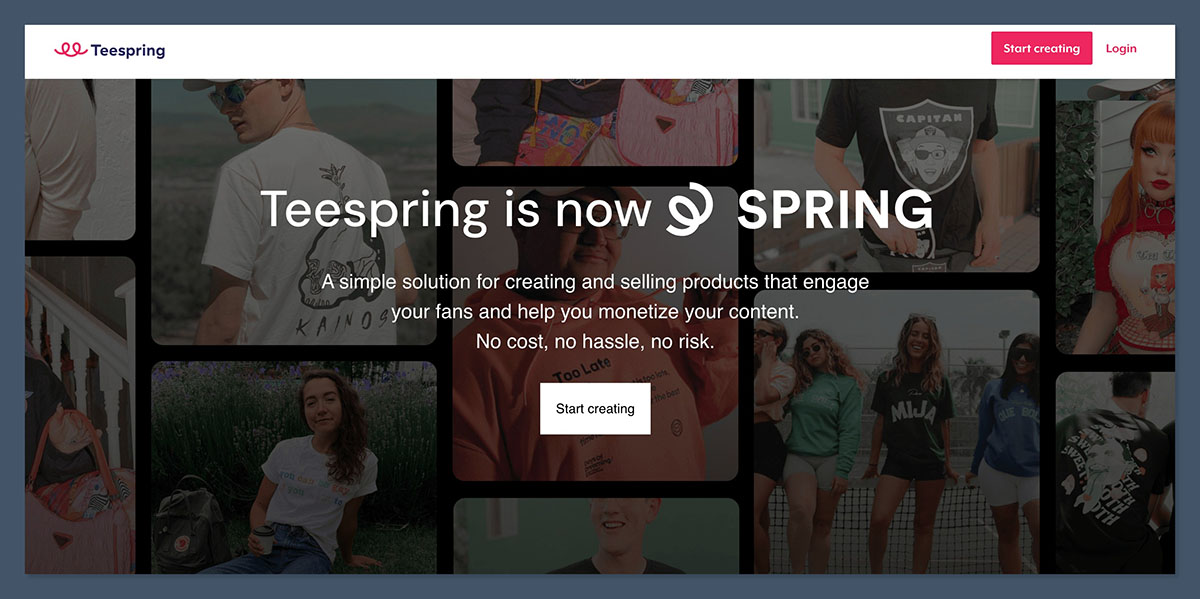
If you don’t want to set up a store, buy a domain, or spend money upfront, Spring (formerly Teespring) is your best option.
It’s designed for creators who want to launch products quickly, with zero startup costs.
You don’t even need a website. You upload your design, set a price, and Spring handles the rest — fulfilment, shipping, and customer support.
It’s not the most flexible platform, but it’s incredibly simple to use — and that makes it a good first step into print on demand.
What makes Spring different from platforms like Printify or Printful is the built-in marketplace.
People can technically discover your products on the platform itself (though this traffic is limited), and there’s no need for outside integrations like Shopify or Etsy.
Good for Zero Setup:
- No cost to start — no subscriptions, no listing fees
- No need to connect a storefront — the product pages are hosted by Spring
- Built-in traffic (mostly from creator marketplaces, social integrations)
- No handling of orders, fulfilment, or customer service
For anyone building an audience on YouTube, Instagram, TikTok, or even Twitch, Spring removes all the backend stress. You just design, promote, and get paid when sales come in.
Pros:
- Extremely beginner-friendly
- Handles everything: fulfilment, returns, customer support
- You can create a storefront with product mockups in minutes
- Great for testing out design ideas without spending money
- Social platform integrations: YouTube Merch Shelf, Linktree, etc.
Cons:
- Profit margins are slim, especially if you price too low
- Limited product customisation and design control
- Branding is basic — you won’t get custom labels or packaging
- No access to customer data, which limits email marketing or retargeting
- Marketplace traffic is small compared to Etsy or Redbubble
Best For:
Spring is ideal for creators, influencers, and beginners who want to sell merch without launching a full ecommerce site.
I wouldn’t recommend Spring for someone trying to build a long-term brand or optimise for profit margins.
But if you’re focused on testing designs, building awareness, or monetising a personal brand without investing upfront, it’s one of the easiest ways to start.
Example Margin Breakdown:
| Product | Base Price (Estimated) | Your Price | Estimated Profit |
|---|---|---|---|
| Unisex Tee | $10.22 | $24.99 | ~$8–$10 |
| Hoodie | $21.99 | $39.99 | ~$10–$12 |
| Mug | $8.75 | $14.99 | ~$4–$5 |
Just keep in mind that if you’re not bringing your own traffic (from social media or a newsletter), it’s hard to get traction purely from Spring’s marketplace.
That said, the low risk and fast setup make it a great sandbox for creators dipping their toe into POD.
5. Redbubble – Best Passive Marketplace
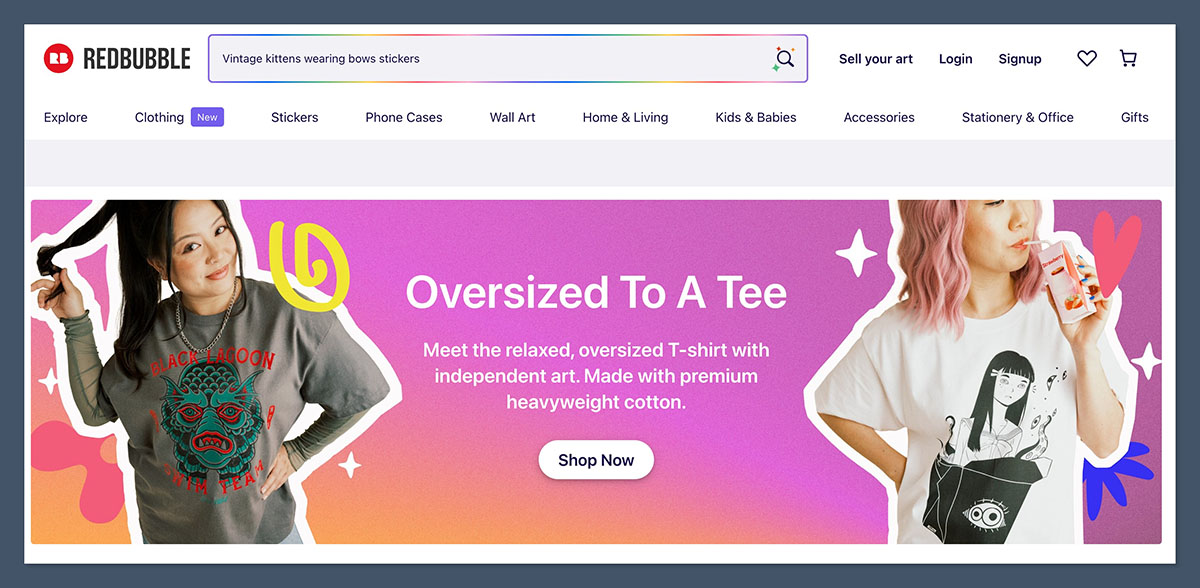
Redbubble is one of the most hands-off ways to make money with print on demand. You upload your designs, apply them to multiple products, write your titles and tags, and let the marketplace handle everything else.
There’s no storefront to manage, no customer service to worry about, and no upfront investment.
It’s not going to make you rich overnight — but if you upload consistently, niche down, and follow good SEO practices, it can bring in steady sales for years.
Why It’s Good (and Bad):
- Great for passive income if you’ve got strong designs and keywords
- Zero setup or costs — your account and listings are free
- You set your profit margin on top of Redbubble’s base pricing
- Wide variety of products: shirts, stickers, wall art, home decor, accessories
What makes Redbubble different from platforms like Printify or Gelato is that it’s not tied to a store you control. It’s a built-in marketplace, more like Etsy.
People come to Redbubble, search for a niche, and browse what’s already there. That gives you exposure — but also limits your control over the customer experience.
Pros:
- Easy to get started — no tech skills needed
- You don’t have to handle shipping, returns, or customer questions
- Marketplace has built-in organic traffic from search engines and internal recommendations
- Upload once, and your designs stay live for years
- Broad product range that updates automatically with your artwork
Cons:
- Base prices are high, so profit margins are low unless you price carefully
- You can’t brand the products or the packaging
- You don’t get any customer data — so there’s no email marketing or retargeting
- Competitive marketplace — you’ll need good keywords and fresh designs
- Payment delays — Redbubble pays monthly, and there’s a payout threshold
Best For:
Redbubble works best for designers, illustrators, and artists who want a low-maintenance, low-risk way to monetise their work.
It’s also a smart place to validate your niche or style before investing in your own Shopify store or ad campaigns.
If you’re good with SEO, niche research, and design tools like Photoshop or Canva, Redbubble can be a passive POD income stream that runs quietly in the background.
Example Earnings Breakdown:
| Product | Base Price (USD) | Suggested Retail | Artist Margin (20%) |
|---|---|---|---|
| T-shirt | $13.00 | $18.00–$22.00 | $2.60–$4.40 |
| Sticker | $2.50 | $3.50–$4.00 | ~$0.70 |
| Art Print (A4) | $14.00 | $18.00–$22.00 | $3.00–$4.00 |
Margins are tight, especially for lower-priced items like stickers, but volume is the play here.
The more designs you upload, the better chance you have of ranking in niche search results and collecting consistent sales over time.
Bottom line: if you want to test POD without committing to a full store or ads — and you’ve got a backlog of designs ready to go — Redbubble is a great way to dip your toe into passive income without any upfront spend.
6. Zazzle – Great for Stationery and Invitations
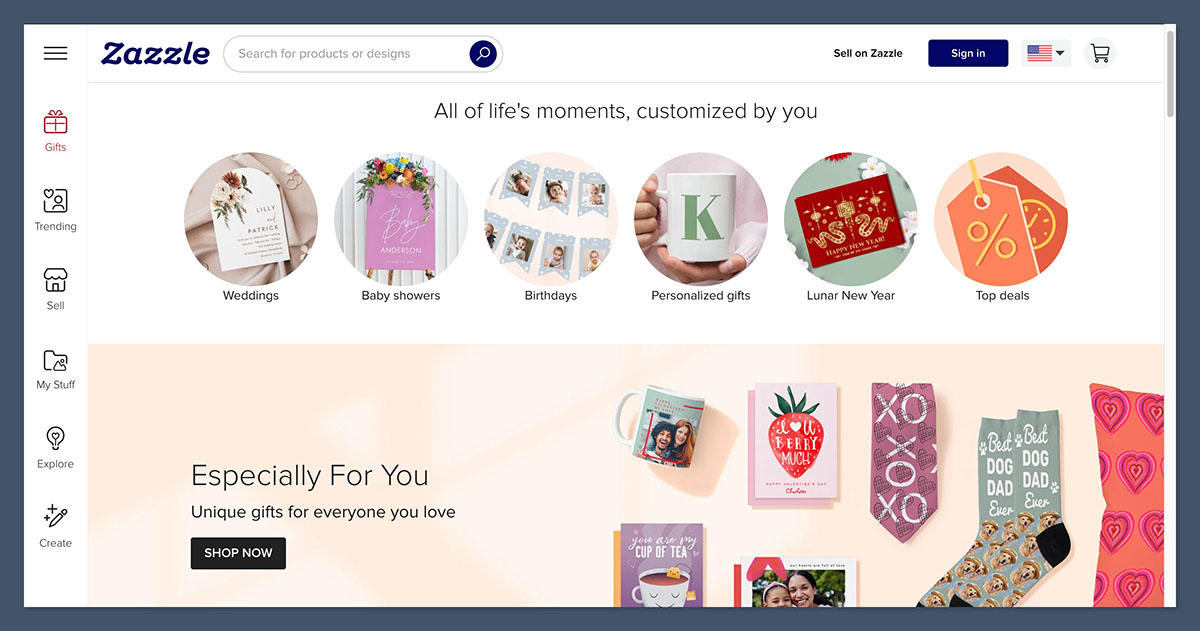
Zazzle has one of the most diverse and niche-focused product libraries in the print on demand space.
While most POD platforms focus heavily on apparel, Zazzle shines in areas like custom invitations, wedding stationery, business cards, stickers, and office supplies.
If you’re a designer who’s more into paper goods or gift items than clothing, this is one of the best platforms to sell on.
The Zazzle marketplace caters to people looking for personalised products — everything from holiday cards to graduation announcements — and that opens up a whole different set of selling opportunities.
You won’t get the same level of control or branding options as a platform like Printful, but you don’t need to worry about fulfilment or overhead, either.
What You Should Know:
- Base prices vary widely by product — apparel, paper goods, and accessories are all priced differently
- You earn royalties on top of Zazzle’s set base price — usually 5% to 15%, adjustable
- No subscription fees or setup costs
- Product customisation is done by the buyer through the design interface
Zazzle is built more like a template-driven marketplace than a traditional POD platform.
That makes it ideal for sellers who specialise in event-based designs, personalisation, or simple text-based templates.
Pros:
- Excellent for niche-specific items like wedding invites, baby shower cards, planners, and desk calendars
- Built-in marketplace traffic with millions of monthly users
- Easy to list products without managing fulfilment or customer service
- Product library includes over 1,000 categories, many not available on other POD platforms
Cons:
- Hard to build a standalone brand since Zazzle controls most of the customer experience
- Royalty-based pricing model limits your control over profit margins
- Not ideal for apparel — higher base prices and fewer style options
- Product listings can be competitive and SEO-heavy
Best For:
Zazzle is a great choice for designers focused on events, paper goods, and functional products.
You won’t scale fast with Zazzle, but the right niche + seasonal timing can bring in consistent, passive sales with very little maintenance.
Example Royalty Breakdown:
| Product | Base Price | Retail Price | Artist Royalty (10%) |
|---|---|---|---|
| Wedding Invitation Set | $2.50 | $3.00 | $0.30 |
| Business Card Pack | $18.00 | $20.00 | $2.00 |
| Sticker Sheet | $4.50 | $5.00 | $0.50 |
To boost margins, sellers can set royalties higher than 10%, but keep in mind that raising prices too much can hurt your conversion rate.
If your creative strengths lie in typography, layout, or seasonal design work, Zazzle is a solid passive income platform — especially during peak gifting and event months.
7. SPOD (Spreadshirt) – Best for Fast Production
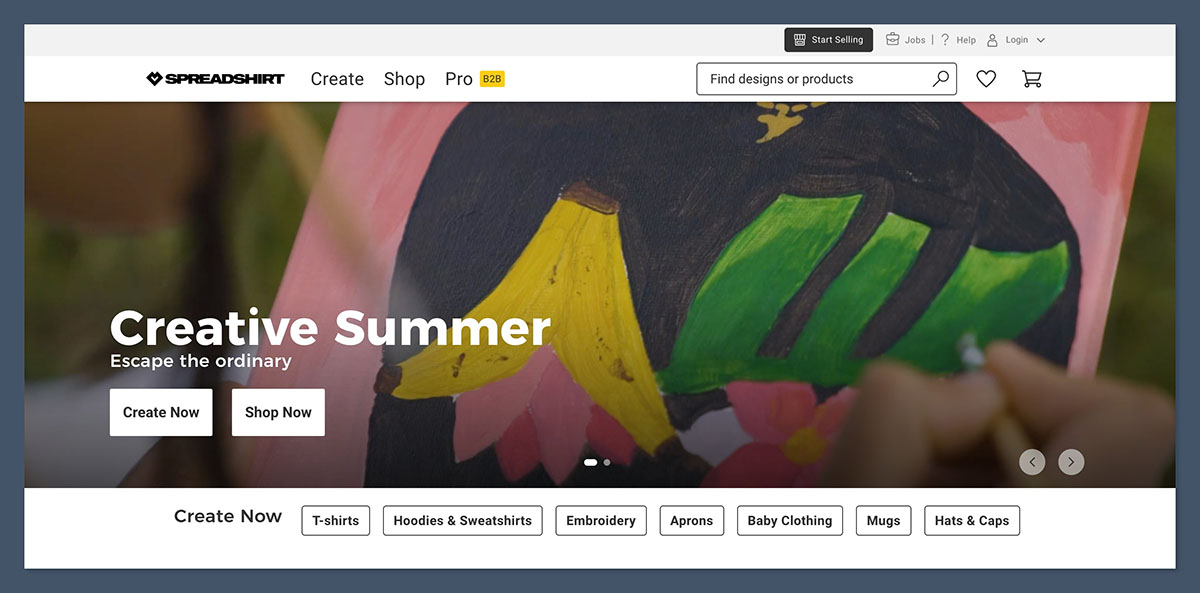
SPOD (short for Spreadshirt Print-On-Demand) has carved out a reputation as one of the fastest fulfilment providers in the industry.
Their biggest advantage is speed: over 95% of orders are produced and shipped within 48 hours. That alone makes them a strong option if you’re selling to customers who care about fast delivery.
Speed isn’t the only thing SPOD gets right. They also offer competitive pricing, solid print quality, and a clean integration with Shopify.
For sellers who want quick turnarounds without the high cost of premium services like Printful, SPOD hits a good balance.
Why I Like SPOD:
- Cheap base price: T-shirts start at $6.39, making it one of the lowest-cost options
- Consistently fast production — often within 24 to 48 hours
- Print quality is reliable and holds up well after washes
- Ships from US and EU fulfilment centres
This speed makes SPOD particularly effective for time-sensitive niches — think holiday drops, last-minute birthday gifts, or fast-moving meme designs.
Pros:
- Fastest production times in the POD space
- Low base pricing for common items
- Easy-to-use product creator and Shopify integration
- Print quality is solid for the price point
- European fulfilment available for faster delivery in EU
Cons:
- Smaller product range compared to Printify or Printful
- Limited branding options — no custom labels or premium packaging
- International shipping can get expensive, especially outside the US or EU
- No marketplace or organic discovery — you’ll need to bring your own traffic
Best For:
SPOD is perfect for sellers who need speed. If fast fulfilment is your competitive edge, or you’re in a niche where shipping delays kill sales, SPOD is your go-to.
It’s also great for Shopify sellers who want something fast and low-cost without building out a full branding stack.
It’s not the right choice if you need custom packaging, premium branding, or a massive catalog of accessories — but for standard T-shirts, hoodies, and mugs, it gets the job done quickly and reliably.
Pricing Summary:
| Product | Base Price | Shipping (US) |
|---|---|---|
| Unisex T-shirt | $6.39 | $3.57 |
| Hoodie | $19.49 | $6.99 |
| Mug | $5.85 | $5.00 |
In the POD world, speed matters. Whether you’re running limited-time promotions or just want fewer angry emails asking about late deliveries, SPOD gives you a real operational edge.
Side-by-Side Price Comparison Table
| Platform | T-shirt Price | Shipping (US) | Strength |
|---|---|---|---|
| Printify | $7.50 | $4.00 | Cheapest product options |
| Gelato | $8.95 | $3.00–$5.00 | Global delivery efficiency |
| Printful | $12.95 | $3.99 | Premium branding + quality |
| Teespring | $10.22 | Free | No-cost startup |
| Redbubble | $13.00+ | Included | Passive marketplace sales |
| Zazzle | Varies | $3.00+ | Best for paper goods |
| SPOD | $6.39 | $3.57 | Fastest fulfilment |
Pros and Cons of Using Low-Cost POD Providers
Going cheap can save you upfront — but it’s not without trade-offs. The lowest price doesn’t always equal the best value.
Over the years, I’ve tested most of the low-cost platforms on this list, and here’s what I’ve learned through experience.
It’s true that lower base prices can open up your margins. That’s great for scaling ad campaigns or offering discounts without destroying your profits.
But you have to stay aware of what you’re giving up — and whether it’s worth it in your niche.
Pros:
- Better profit margins if you control shipping and production variables
- Lower barrier to entry — you can launch without a big budget
- Easier to test multiple designs before committing to ads or branding
- More flexibility in pricing, especially when running sales or bundles
- Good for seasonal or viral products where quality may not be as critical
Cons:
- Inconsistent product quality, especially across different Printify or low-tier suppliers
- Packaging tends to be generic and unbranded, which weakens brand trust
- Customer retention is harder when presentation or quality disappoints
- Fewer support options, especially during Q4 or high-volume seasons
- Limited or no access to branded add-ons like labels, tags, or custom inserts
It comes down to your strategy. If you’re focused on quick testing or riding trend waves, low-cost providers give you the agility you need.
But if your brand is built on experience and quality, cutting corners on fulfilment can backfire.
Final Thoughts: What’s the Best Cheap POD Option?
If I had to recommend just one low-cost print on demand provider for most sellers, I’d say go with Printify.
It gives you the most control over suppliers, offers the lowest base prices on staple products, and gives you the option to scale globally through their supplier network.
The Premium plan is worth every dollar if you’re doing even moderate monthly volume — that 20% discount can significantly lift your margins, especially on T-shirts, mugs, and hoodies.
But the “best” option really depends on your business model:
- Need fast fulfilment? Use SPOD — it’s the fastest POD partner I’ve tested, with consistent 48-hour production.
- Selling internationally? Go with Gelato — their local fulfilment network covers 30+ countries, and you’ll avoid most import headaches.
- Building a premium brand? Spend the extra with Printful — better packaging, better unboxing, better customer satisfaction.
There’s no universal answer here. The right POD provider comes down to your store strategy, your target customer, and your budget.
Don’t get caught up in which platform is “best.” Focus on what fits your margin goals, your shipping needs, and how much branding control you want.
And no matter who you go with — always test first.
